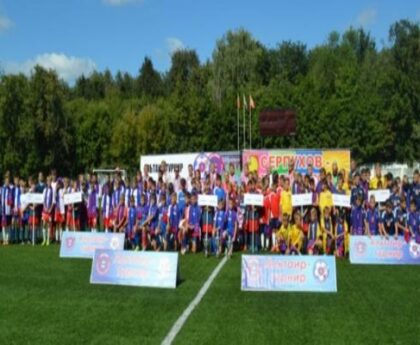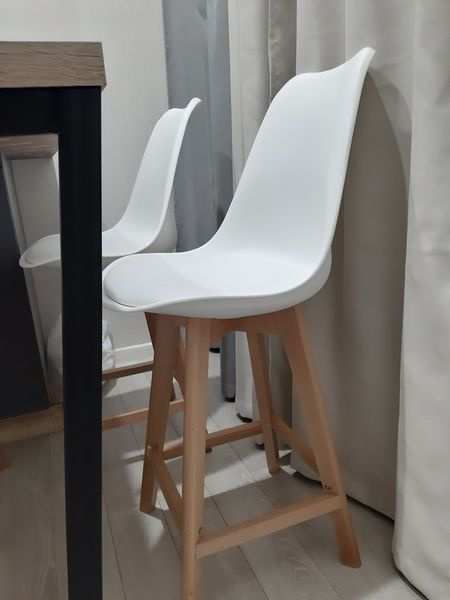Since 2011, 1820 objects of cultural heritage have been restored in the capital.
Sergey Sobyanin presented awards to honorary restorers in Moscow
.jpg)
The restoration of the Little Russian courtyard on Maroseyka ended. Sergei Sobyanin examined the restored object and presented the badges for the rank of Honorary Restorer of the city of Moscow.
“Moscow has passed many crises over 10 years, many problems. Nevertheless, for not a single month, not for a single year, a large -scale restoration program, restoration of history monuments, and culture of Moscow stopped for a single year. Over the years, about two thousand objects have been restored. Last year alone, we finished the restoration of 200 objects, this year – 66, although the year has just begun. And the whole program that we planned decided to leave in full, despite economic difficulties. This is not only the creation of jobs for restorers, builders, engineers, architects, but, of course, the continuation of the restoration of our beloved city, ”said the mayor of Moscow.
Sergei Sobyanin thanked the restorers and architects who devoted most of his lives to the restoration of many monuments of the city, beloved by Muscovites and guests of the capital.
The history of the Little Russian Compound
The Little Russian Compound is one of the oldest buildings in the capital. Elena Odinets, the chief architect of the restoration project, did a great job with colleagues, said Sergey Sobyanin.
“We managed to return it to the city as an apartment building, there are unique apartments,” said Elena Odinets. “There are few such chambers in Moscow.”
The Little Russian Compound is located at the address: Maroseyka Street, house 11/4, building 1. In the first half of the 17th century, mainly foreigners lived in this quarter. Among them was the Hanseatic merchant D.N. Rutz, who in the 1630-1640s began to build stone chambers in his yard. Soon, the chambers were significantly expanded and adapted for the Danish courtyard.
In 1652, the possession passed into the state treasury, for a long time was empty and then transferred to the to the embassy order.
In 1690, the chambers of the embassy court passed to the stolnik V.F. Naryshkin, cousin of Queen Natalia Naryshkina. It was at this time that the chambers received a new decor of facades in the style of Naryshkinsky Baroque.
In 1702 after the death of V.F. Naryshkina in this building was the gymnasium of Pastor Gluck. And after the fire of 1707, Peter I granted the estate to one of his associates – Count C.L. Raguzinsky, who rebuilt the building in the style of Western European architecture.
In 1764, possession passed to Prince M.D. Kantemiru, who designed facades in the style of Moscow Baroque. At that time, it included the central chambers supplemented by the third floor. And on the sides of the courtyard were wings with a house church in the West.
In 1791, Prince N.V. acquired possession Repnin.After his death in 1801, the house remained in the ownership of his daughters for another two decades. During the fire of Moscow in 1812, Repnin's old house on Maroseyka was not damaged.
In 1825, the property was acquired by the Moscow Trustee Committee of the Imperial Philanthropic Society and decorated in the Empire style. After the renovation, the Marosei almshouse was placed in the building.
In the 1870s, the building on Maroseyka was again repaired and redevelopment was made there. Part of it has been subdivided into residential apartments for rent. It was during this period that the brick vaults in the rooms were covered with hemmed flat ceilings, which reduced the overall height of the rooms and simplified the issue of heating. In the central part of the building, instead of the old wooden one, a multi-flight staircase was arranged up to the third floor with figured metal railings. The ceilings were decorated with profiled rods and rosettes in the center of the rooms.
In the 1880s–1910s, in addition to residential apartments, the building housed the Elizabethan Women's Gymnasium, a needlework school, a pharmacy, a printing house with a shop, and a church on the third floor.
In the Soviet years, apartments were located on the upper floors, and on the ground floor there were trade and consumer services. Numerous redevelopments were made.
In the 1960s, the building was taken under state protection as an object of cultural heritage (Decree of the Council of Ministers of the RSFSR of August 30, 1960 No. 1327).
In the 1970s, the forces of Mosproekt-2 named after M.V. Posokhin, a survey and restoration of the architectural monument were carried out. As a result, on the courtyard facade in the central part to the right of the passage arch, specialists restored white-stone architraves of the end of the 17th century in the Moscow Baroque style. Traces of cut shoulder blades and cornices from the 17th century were also found. However, the interiors of the Little Russian Compound awaited the full attention of restorers for almost 50 more years. In the early 2000s, the tenants of the building were resettled.
How was the restoration
From 2018 to 2021, the owner of the building carried out a comprehensive restoration, including research work, of the Little Russian Compound on Maroseyka. Specialists restored the unique historical appearance of the architectural monument and adapted it for modern use.
The work was carried out through private investment, the total amount of which amounted to almost 1.5 billion rubles.
After the restoration, the building retained its historical function – a residential apartment building with a total area of 4.5 thousand square meters.
The first floor was left uninhabited, there were provided premises for offices. On the second and third floors there are 29 apartments with finishing. The building is flanked on the sides by two-story outbuildings, in which four more apartments are equipped with separate entrances from the courtyard.
Non-bearing internal later partitions were completely removed during the work, leaving the historical load-bearing brick walls that form the original layout of the building (chambers or halls) – high spaces with brick vaults.At the second stage, the restorers opened the entire brick, preserving its surface as much as possible wherever possible, with its texture, stamps, white stone inserts and masonry from different eras. Made it a key element in the decoration.
Compact volumes were placed inside each ward, accommodating modern functionality: bathrooms, kitchens, wardrobes, dressing rooms, and on the second level the space was zoned for the hallway, living room, dining room and bedrooms. New structures, partitions and details are made in a modern style of laconic minimalism, which effectively emphasizes the historical interiors of the building.
.jpg)
.jpg)
.jpg)
.jpg)
.jpg)
.jpg)
.jpg)
.jpg)
The surviving fragments of painting, which were located in the premises of the former church on the third floor, have been restored. The murals were made at the end of the 19th century by unknown masters in the style of the so-called church academy, common for that time. In connection with the emergency state of the vaulted ceiling, it was decided to dismantle the valuable fragments of painting, their subsequent conservation, restoration and bringing them into an exposition state. Today, restored fragments of paintings with images of Christ the Savior, saints, images of the Holy Spirit in the form of a dove, heads of cherubs are exhibited in the corridors leading to residential apartments.
The object became a laureate of the competition of the Government of Moscow Moscow Restoration – 2021 in two categories:
— Elena Odinets, chief architect of the restoration project, was awarded for scientific and methodological guidance during the repair and restoration work at a cultural heritage site;
– for the best organization of repair and restoration work at a cultural heritage site – Yuri Roga, General Director of Avangard LLC (posthumously).
Moscow restoration: results of 2021
Moscow is one of the world leaders in the field of historical and cultural heritage preservation.
Since 2011, 1,820 cultural heritage sites have been restored in the capital. As a result, the share of Moscow monuments in unsatisfactory condition has decreased from 39 percent (2010 figure) to 4.5 percent. The restoration of monuments in Moscow is carried out at the expense of the city and federal budgets, private investors and patrons.
In 2021, the city continued to implement the world's largest program for the restoration and revival of architectural monuments and other cultural heritage sites. Work was carried out on 620 objects, 206 of which have been completed. In January-April 2022, work was completed on the restoration of another 66 monuments of Moscow architecture.
At the expense of the city budget in 2021, they put in order:
– Gymnasium named after Ivan and Alexandra Medvednikov, 1903, architect I.S. Kuznetsov. Here, in 1941, the 21st division of the people's militia was formed (Starokonyushenny lane, house 18);
– sculptures on Gagarin Square, late 1940s, architects I.I. Fomin, E.A. Levinson, A.E. Arkin, sculptor A.E.Gromov (Leninsky Prospekt, house 37);
– Four objects of the repnins estate – Volkonsky – Mukhanov Vorontsovo – Vorontsovsky park.
At the expense of the federal budget, they restored:
-Museum-Quarter F.M. Dostoevsky, located in the lateral outbuilding of the former Mariinsky hospital for the poor, the beginning of the 19th century (Dostoevsky Street, house 2);
– Museum of Paul and Sergey Tretyakov – a branch of the Tretyakov Gallery. Until 1846, the founder of the Tretyakov Gallery P.M. Tretyakov and a prominent figure in Moscow city self -government, collector S.M. Tretyakov (1st Golvinsky Lane, house 16, structure 1);
– Facades of the 1928 residential building, architect A.Ya. Langman (Milyutinsky Lane, house 9, structure 1);
– The facades of the mansion of Savva Morozov, the end of the XIX century, architect F.O. Shekhtel (Spiridonovka street, house 17, building 1).
Private investors repaired:
-building of the Central Electric Station of the City Tram-House of Culture GEC-2 1904-1908 of the construction, architect V.N. Bashkirov (Swamp Embankment, house 15, structure 1);
– The apartment building of the merchant V.E. Bykova (2nd Brest Street, house 19/18, building 1);
– superstructure of the third floor and the design of the street facade of the early 19th century of the Little Russian Compound (Maroseyka Street, house 11/4, building 1);
– the ensemble “Two houses with two outbuildings and gates”, erected at the beginning of the 19th century (Nikolayamskaya street, house 53, buildings 1, 2, 3);
– the tenant house of 1908 in the city estate of the Sokolov – Sibiryakovs, XIX – XX centuries, architect V.I.Masnikov (Voznesensky Lane, house 11, building 3);
– The facades of the building of the Metropol Hotel, built in 1899-1903 (theater passage, house 2).
Plans for 2022
Today in Moscow there are 902 permits to maintain cultural heritage objects: 604-for production work and 298-for research.
Work continues at some iconic objects:
– Educational House of 1764-1770, built according to the project of architect Karl Blanca (Kitay -Gorodsky passage, house 9);
– Moscow Imperial Post Office and Telegraph, XVIII – the beginning of the twentieth century (Myasnitskaya Street, house 26a, building 1);
– The main house of the city estate of Batashev (Yauzskaya street, house 11/6, building 1);
– Church of St. Nicholas on three mountains (Novovagankovsky Lane, house 9);
– The temple of the holy apostles Peter and Paul (New Basmannaya street, house 11).
Restoration at VDNH
The largest restoration site in Moscow in recent years is an exhibition of achievements of the national economy (VDNH).
Over the past eight years, large -scale work on the restoration and improvement of the territory has passed here. In 24 historical pavilions and other cultural heritage sites, a comprehensive restoration ended.
Currently, work continues at 15 cultural heritage sites of VDNH, including: Pavilions No. 1 Central – work is underway to adapt to the museum exposition,No. 2 “Folk Education” (former pavilion of the North Caucasus), No. 4 “Biology” (former Pavilion of the Estonian SSR, transferred to the Republic of Kyrgyzstan), No. 6 “Chemistry” (former Pavilion of the Lithuanian SSR, transferred to the Republic of Abkhazia), No. 8 “Young Naturalists , No. 15 Radio Electronics and Communications (former Pavilion of the Volga region), No. 35 Glavtabak , No. 51 Meat Industry (former Pavilion Glavmyaso ), No. 59 Grain (former pavilion of the Moscow region), No. 61 Central Union ”, No. 64“ Optics ”(former Pavilion of Leningrad and North-West), No. 66“ Republic of Uzbekistan ”(former Pavilion“ Soviet Culture ”, Uzbek SSR), No. 68“ Armenia ”(former Pavilion“ Siberia ”), cafe) Summer (former Pavilion Tea), as well as the Green Theater.
Program 1 ruble per 1 square meter
Since 2012, the capital has been in the capital for the restoration of emergency architectural monuments “1 ruble per 1 square meter”. Within its framework, investors were engaged in 26 objects, today a comprehensive restoration of 20 buildings ended, including in 2021, they completely restored the Naumovs – Volkonsky residential building on the Prechistenka (house 36, building 2).
Six more architectural monuments are put in order:
– The main house of the 1898 construction in the city estate of Morozov, the end of the XVIII – XIX century (Nikolayamskaya street, house 47);
– In the ensemble of profitable houses, Grigory Gorbunov will restore a apartment building with a printing house of 1905, architects Julius Diderichs and Olgerd Pyotrovich. Here in 1908-1917, Old Believer literature was published (Ninth Street, house 16);
– the outbuilding of the city estate of the beginning of the 19th century (Gorokhovsky Lane, house 19, building 4);
– residential building of the beginning of the XIX century (barracks, house 10, building 3);
-Khoroshevsky horse factory of the second half of the 18th century, since the 1830s, who worked as a military warehouse, as well as the passage gate and guardhouse of the 1770s (Tamanskaya Street, house 2, building 8);
– The apartment building of 1871 buildings (Kropotkinsky lane, house 10, building 1).
Restoration of monuments and tombstones
The capital continues to restore works of monumental art, architectural and artistic tombstones and objects of historical and military necropolis, which are objects of cultural heritage.
Restoration work has completed 22 burials with art tombstones in Armenian, Vagankovsky, Pyatnitsky, Vvedensky and Danilovsky cemeteries.
In addition, monuments to Ivan Krylov were put in order in the square near the patriarchal ponds, the heroes of the Plevna in the Ilyinsky Square, the participants of the Moscow December Armed Uprising of 1905 in the Perovsky Park, Nile Filatov in the square on Bolshaya Pirogovskaya Street.
For 11 years, more than 120 monuments and about 480 architectural and artistic tombstones and objects of historical and military necropolis were restored in total.
The plans for this year include the restoration of 73 tombstones and a chapel-spy on the territory of the Necropol of the Donskoy Monastery and the Don cemetery, as well as one tombstone and one chapel-seeker at the Vvedensky cemetery.
Honorary restorers in Moscow
By decree of the Moscow Mayor for a great contribution to the preservation of cultural heritage objects and many years of fruitful work in the field of restoration of the title “Honorary Restorer of the City of Moscow”, they were awarded:
-Victor Golub, chief architect of Renaissance Restation JSC;
-Pavel Kotelnikov, artist-restorer of the State Scientific Research Institute of Restoration;
– Vladimir Kuznetsov, chief architect of SimstroServis LLC.
Victor Golub works in the field of preserving cultural heritage objects 37 years. Under his leadership, measurements and research of architectural monuments, sketch and working restoration projects are carried out. Viktor Demidovich carries out copyright supervision of restoration work at cultural heritage sites. Over the past five years, with his participation in Moscow, work has been completed and restoration projects have been prepared, including the Catherine Palace, the house of 1793-1802 in Bolshaya Spasoglinischevsky Lane, Pavilions No. 6 “Chemistry”, No. 31 “Geology”, No. 44 “Rabbit growing” and No. 58 Agriculture at VDNH.
Pavel Kotelnikov has been dealing with the preservation of monumental sculpture, architectural decor and monuments of decorative art (interior storage) for more than 30 years. He conducted studies associated with the processes of the destruction of metal in atmospheric conditions, in the open air and the development of ways to increase its durability, the author of several techniques implemented in restoration practice. He is an artist-restorer of the highest category. In his track record, the restoration of the monument A.S. Pushkin on Pushkinskaya Square, copper sculpture “Worker and collective farmer” on the roof of the central pavilion of VDNH, the monument to V.I. Lenin at VDNH, monuments Earth and Water in Luzhniki, copper sculpture Builders of communism on the facade of the skyscraper on the Kotelnikiye embankment, the burial of N.G. Tarasov in the Armenian cemetery, the burial of the Adeelheim brothers, Franz Yanik and the Flaw Flambing Fla pain in the Vvedensky cemetery, the Morozov family section in the Preobrazhensky cemetery. Currently, Pavel Nikolaevich leads the restoration of salaries of the iconostasis of the Smolensk Cathedral of the Novodevichy Monastery and the monument to Minin and Pozharsky, which are planned to be completed in 2023.
The experience of Vladimir Kuznetsov at cultural heritage sites is more than 40 years. Vladimir Ivanovich is the author of the restoration projects of many cultural heritage objects of Moscow, including the building of the Russian Academic Youth Theater of the Order of Lenin, the fur store and the factory Trading House A.M. Mikhailov ”, interiors of the Yaroslavl station, the apartment building of the merchant V.E. Bykov.
The title “Honorary Restorer of the City of Moscow” was established in 2013 and is assigned to industry specialists who have achieved outstanding successes in the preservation and restoration of cultural heritage sites located in Moscow.Candidates for the assignment of the rank should have the experience in the restoration industry for at least 20 years.
Over the past years, 43 people were awarded this award, including awarded in 2022.
According to the prevailing tradition, the presentation of badges for an honorary title takes place in the spring. This year it is timed to the International Day of Monuments and Historical Places (April 18).




